Girl may have lived if treated for blood loss at Arena bomb scene, inquiry hears
Eight-year-old Saffie-Rose Roussos was five metres away from suicide bomber Salman Abedi as he detonated his device.

The youngest victim of the Manchester Arena terror attack probably would have survived if a “window of opportunity” was not missed to treat her at the scene, an inquiry has heard.
Eight-year-old Saffie-Rose Roussos arrived at Royal Manchester Children’s Hospital some 52 minutes after the explosion in the City Room foyer of the venue, at the end of an Ariana Grande concert on the evening of May 22 2017.
She went into cardiac arrest shortly after she entered the hospital’s resuscitation room and despite the efforts of medics she was pronounced dead at 11.40pm.
This week the public inquiry into the atrocity, which killed 22 people and injured hundreds of others, is focusing on whether Saffie-Rose, from Leyland, Lancashire, could have lived if she had received different or additional treatment.
A panel of blast wave experts has told the inquiry her multiple injuries were unsurvivable, but experts commissioned by lawyers for the youngster’s family disagree.

On Friday, Dr Gareth Davies and Lt Col Claire Park said the injuries could not have been as serious as outlined by the blast wave panel, because Saffie-Rose was able to live so long without any meaningful intervention.
Dr Davies, a former medical director of London’s Air Ambulance, who has responded to numerous major incidents, including the July 7 2005 bombings, said she should have received crucial treatment in the City Room for her blood loss.
He said: “We believe the window of opportunity to provide therapy for Saffie actually begins in that room and it begins with the EMT (emergency medical technician) who tended Saffie.
“They have the key skills and equipment to provide treatments that are important to Saffie, namely splintage, traction and tourniquets.”
The inquiry has heard that an Arena first-aider, trained to perform the role of EMT, assessed the youngster as she was lying on the floor, but moved on to assist other casualties as she thought she was not breathing and could not see signs of catastrophic bleeding.
Paul Greaney QC, counsel to the inquiry, asked Dr Davies: “Let’s assume those three measures had been taken, what is your view about the impact of those measures on Saffie’s survivability?
He replied: “The effects of those measures can be quite profound in terms of traction and splinting, and would have every expectation of improving the situation.”
Dr Davies added it was “more likely than not” she would have survived.
Saffie-Rose asked for her mother as she lay on the floor following the blast, the inquiry has heard, and her condition deteriorated in time as a T-shirt seller, an off-duty nurse and two police officers were forced to carry her out of the City Room foyer of the venue on a bloodied advertising board.
One of the police officers had to flag down an ambulance outside and later Saffie-Rose asked a paramedic in the back of the vehicle: “Am I going to die?”
Dr Davies said a similar treatment intervention should have taken place in the ambulance before she was taken to hospital.
Mr Greaney asked: “If those measures had been taken in the ambulance would that have improved Saffie’s prospects of survival?”
Dr Davies replied: “Without a doubt. There is potentially a window of 20 minutes where those interventions could have been in place and acting before Saffie enters cardiac arrest.
“If you are not taking those measures you are committing her (Saffie) to continuing haemorrhaging.
“I would have expected paramedics and technicians to apply these techniques in this situation. I recognise that it’s very emotional and time pressured, that there is a need to get to hospital. You have to back a horse.
“I think at this point we believe she probably would have still lived.”
Lt Col Park said she thought survival was “less likely” at this point but still “possible”.
Dr Davies added: “Her chances have certainly degraded. I think the strategy for survival here is stop the bleeding as early as possible.”
The paramedic who treated Saffie-Rose previously told the inquiry she did not see any external bleeding and said she thought her only chance of survival was blood transfusion and surgery at hospital.
Both Dr Davies and Lt Col Park emphasised that everyone who assisted Saffie-Rose at the scene “recognised the seriousness of her condition and cared for her with compassion and a clear desire to help save her life”.
However in their opinion, they concluded her injuries “were not incompatible with life”.
They said an operation known as a resuscitative thoracotomy should have been performed on Saffie-Rose at the hospital, but accepted by this time the “chances of survival were stacked against her”.
They disagreed with the blast wave panel over the severity of the vascular and lung damage sustained by the youngster.
Saffie-Rose had earlier enjoyed the “night of her life” with her mother, Lisa, and older sister, Ashlee, as she watched her idol Grande perform.
She was five metres away from suicide bomber Salman Abedi as he detonated his device, packed with nuts and bolts, and received more than 100 injuries.





